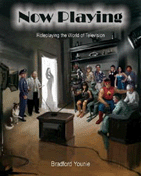
|
About OgreCave and its staff
|

|
by Matthew Pook
Since 1980, with the publication of SPI’s Dallas RPG, television has been a rich source for the roleplaying industry. For example there have been no less than five incarnations of a Star Trek RPG, two for Doctor Who, and more recent TV licensed games like Angel: The Roleplaying Game from Eden Studios and AEG’s Stargate SG-1 RPG. Other than the very first RPG, Dallas, the majority have been taken from what is regarded as genre television - fantasy, science fiction and horror. Rather than being based upon a single show or series, the latest television-themed RPG takes another approach by attempting to encompass all of them within its covers. From cops to romance, from the western to the courtroom drama, and from science fiction to the sit-com, Carnivore Games’ Now Playing covers them all and is designed to help the GM make his game feel like a TV show.
The Studio Tour Now Playing is organized into four sections, themed along televisual lines. Thus “Casting” covers the creation of characters for the game, while “Acting” covers all of the rules needed to play. “Screenwriting” deals with adapting an existing show into Now Playing or in creating a whole new one of the GM’s own devising, as well as creating episodes for either. Finally, “FPI: The Show” is a fully defined television series that includes two ready-to-play episodes. In terms of game system, Now Playing uses the tried and tested Fudge! System. Both attributes and skills are rated by seven competencies, from Terrible and Poor, up through Mediocre, Fair and Good to Great and Superb. To resolve any action against an attribute or skill, four special Fudge dice are rolled. These are ordinary six-sided dice, but instead of being marked with numbers or dots, two faces are blank, two are marked with a minus sign, and the last two with a plus symbol. When rolled, the aim is to get more pluses than minuses, as they cancel each other out. More pluses mean that the effective level of a skill or attribute can be raised, whereas a roll with more minuses will lower it. Character creation involves spending points to raise attributes and skills, and to buy gifts, flaws and possibly powers. Like the core mechanic, the process is not difficult and can be grasped very quickly. A pleasing section that does a fine job of explaining the goals and tasks of a GM follows this in the chapter on “Directing.” Just over a hundred pages are devoted to the rules, which just about touch upon everything a GM might need.
Writing the Script Each section serves as a very basic introduction to each type, but problematically it does no more than that. It should have made some effort to deconstruct each genre and with more thorough examples, perhaps one per genre. This, after all, is what the author is asking the GM to do in adapting a television show into an RPG. Such exercises need not necessarily refer to actual existing shows, but could instead use examples that model the real thing. The author goes into more depth in writing episodes, or rather writing adventures or scenarios in the style of an episode of a television show. The section breaks the anatomy of an episode down to analyze each element before going back through their use in constructing an episode. Though two-thirds the length of the chapter on creating or adapting a show - nine pages as opposed to fourteen - this benefits from more focus, because it only has to concentrate upon the one subject. The example show in Now Playing is “FPI: The Show.” Its genre is that of the paranormal, FPI standing for the, “Foundation for Paranormal Investigation.” It includes a full background, ready to play characters (both leading and supporting cast), notes on the art of ghost hunting and an episode guide for the first season. New rules particular to the FPI series cover psychic powers, ritual magic, the spirit world, strange creatures, and extraterrestrials. None of these subjects are covered in any great depth, but what is given is adequate in terms of the televisual format, which never really goes into any great depth anyway. What “FPI The Show” actually is, is a variation of The X-Files, albeit from a civilian stance rather than a Federal one. Its mandate is the investigation of the paranormal, led by an English ex-army colonel disabled after a very disturbing incident in the first Gulf War. Its treatment of the English aspect of the setting feels very much like that of American television, so the fact that the British Army does not use the Colt 1911 .45 pistol can be overlooked. The characters provided all feel suited to the genre, but suffer from repetition between their listed relationships. The episode listing also includes options for running a series thread along thwarting an alien invasion show called “FPI: Invasion,” or for “FPI: Armageddon,” which is themed on stopping the end of the world. The former is akin to The X-Files, while the latter is more reminiscent of Millennium. Judging from the two ready-to-play episodes included, the first is a murder investigation in a Boston highway tunnel project, and the second a haunting. “FPI: The Show” is not quite as classy as either of the series that inspired it. Not to say that “FPI the Show” would be dreadful as an actual television series, but it is probably not prime time fare. They are decent RPG adventures, though.
Conclusions
|
||
 Now Playing: Roleplaying In Every TV Genre
Now Playing: Roleplaying In Every TV Genre